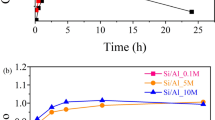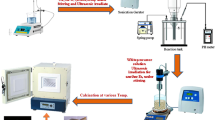Summary
Gallium (Ga) is an effective treatment for the hypercalcemia of malignancy. The mechanism of action of the metal in blocking bone resorption in humans is not well understood. This paper examines the effect of Ga on thein vitro formation of hydroxyapatite (HA) in three test systems that have possible biological relevance in a pH-stat at pH 7.4, 37°C, and 0.15 M NaCl: (1) the direct precipitation of HA; (2) the transformation of amorphous calcium phosphate to HA; and (3) the growth of HA seeds. In addition, the effect of Ga on HA solubility was measured at pH 5.0, the approximate pH of osteoclastic bone resorption. Ga decreased the HA formation and/or growth kinetics in a dose-related manner in all three test systems. In addition, the time to the onset of HA formation was increased in systems 1 and 2. Also, the adsorption of Ga on the surface of HA crystals was measured. Ga reduced the dissolution kinetics of HA compared with Ga-free control. The mechanism reported herein—the significant adsorption of Ga on forming and growing HA nuclei and on the surface of HA crystals—is believed to be responsible for the effects of the metal on HA proliferation and solubility. Accumulation of the metal on newly formed metaphyseal bone can now be explained by this adsorption of Ga. Thesein vitro results partly explain thein vivo action of Ga in treating hypercalcemia by decreasing bone apatite solubility. The similarities in reducingin vitro HA formation rates of aluminum and Ga suggest that patients on long-term Ga therapy for any bone pathology should be carefully monitored for possible osteomalacic complication.
Similar content being viewed by others
References
Warrell RP Jr, Bockman RS, Coonley CJ, Isaacs M, Staszewski HJ (1984) Gallium nitrate inhibits calcium resorption from bone and is effective treatment for cancer-related hypercalcemia. J Clin Invest 73:1487–1490
Bockman RS, Warrell RP, Alcock NW (1985) Gallium blocks accelerated bone resorption in patients with metastatic cancer and increases calcium content of bone. Clin Res 33:576A
Bockman RS, Boskey AL, Blumenthal NC, Alcock NW, Warrell RP Jr (1986) Gallium increases bone calcium and crystallite perfection of hydroxyapatite. Calcif Tissue Int 39:376–381
Boskey AI, Posner AS (1973) Conversion of amorphous calcium phosphate to microcrystalline hydroxyapatite: a pH-dependent solution-mediated, solid-solid conversion. J Phys Chem 77:2313–2317
Blumenthal NC, Posner AS, Holmes JM (1972) Effect of preparation conditions on the properties and transformation of amorphous calcium phosphate. Mat Res Bull 7:1181
Betts F, Posner AS (1974) A structural model for amorphous calcium phosphate. Trans Am Cryst Assoc 10:73
Blumenthal NC, Betts F, Posner AS (1977) Stabilization of amorphous calcium phosphate by Mg and ATP. Calcif Tissue Res 23:245
Betts F, Blumenthal NC, Posner AS, Becker GL, Lehringer AL (1975) Atomic structure of ultracellular amorphous calcium deposits. Proc Nat Acad Sci 72:2088
McGann TCA, Kearney RD, Bucheim W, Posner AS, Betts F, Blumenthal NC (1983) Amorphous calcium phosphate in casein micelles of bovine milk. Calcif Tissue Int 35:821
Gay CV (1977) The ultrastructure of the extracellular phase of bone as observed in frozen thin sections. Calcif Tissue Res 23:215–223
Landis WJ, Glimcher MF (1978) Electron diffraction and electron probe microanalysis of the mineral phase of bone tissue prepared by anhydrous techniques. J Ultrastruct Res 63:188
Walton AG (1967) The formation and properties of precipitates. Interscience, New York, p 30
Jackson SA, Cartwright AG, Lewis D (1978) The morphology of bone mineral crystals. Calcif Tissue Res 25:217–222
Blumenthal NC, Posner AS (1987) Surface poisoning of synthetic and biological apatites. Colloids and Surfaces 26:123
Blumenthal NC, Betts F, Posner AS (1975) Effect of carbonate and biological macromolecules on formation and properties of hydroxyapatites. Calcif Tissue Res 18:81
Cho PW, Fox JL, Higuchi WJ, Pithayanukul P (1984) Influence of dodecylamine hydrochloride adsorption on the dissolution kinetics of hydroxyapatite. In: Miska DN (ed) Adsorption on and surface chemistry of hydroxyapatite. Plenum Press, New York, pp 51–70
Hodsman AB, Sherrard DJ, Alfrey AC, Ott S, Brickman AS, Miller ML, Maloney NA, Coburn JW (1982) Bone aluminum and histomorphometric features of renal osteodystrophy. J Clin Endo Metab 54:539–546
Blumenthal NC, Posner AS (1984) In vitro model of aluminum-induced osteomalacia: inhibition of hydroxyapatite formation and growth. Calcif Tissue Int 36:439–441
Blumenthal NC (1985) Binding of aluminum to hydroxyapatite and amorphous calcium phosphate as a model for aluminum-associated osteomalacia. In: Butler WT (ed) The chemistry and biology of mineralized tissues. EBSCO Media, Birmingham, AL, pp 385–388
Fleisch H, Russell RGG, Francis MD (1969) Diphosphonates inhibit hydroxyapatite dissolution. Science 165:1262
Author information
Authors and Affiliations
Rights and permissions
About this article
Cite this article
Blumenthal, N.C., Cosma, V. & Levine, S. Effect of gallium on thein vitro formation, growth, and solubility of hydroxyapatite. Calcif Tissue Int 45, 81–87 (1989). https://doi.org/10.1007/BF02561406
Received:
Revised:
Issue Date:
DOI: https://doi.org/10.1007/BF02561406




